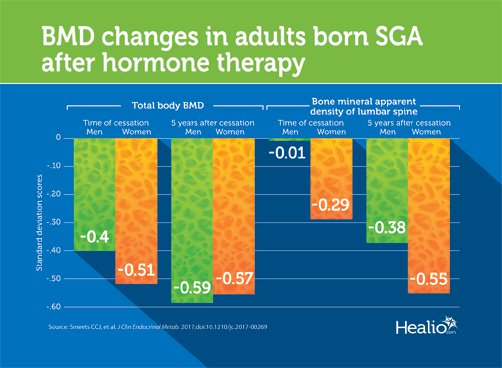BMD declines after growth hormone therapy cessation
Young adults who were born small for gestational age and received growth hormone therapy showed a gradual decline in bone mineral apparent density of the lumbar spine after stopping treatment, researchers in the Netherlands reported.
However, by the time patients were aged 21 years, they demonstrated bone mineral apparent density of the lumbar spine as well as total body BMD similar to that of adults who were born small for gestational age who did not receive hormone therapy.
“Short stature persists in approximately 10% of children born small for gestational age,” Carolina C.J. Smeets, MD, of the department of pediatrics and subdivision of endocrinology at Erasmus University Medical Center in Rotterdam, and colleagues wrote. “Short children born [small for gestational age] can nowadays be treated with GH during childhood to improve adult height. GH treatment also improves BMD [of the total body] and [bone mineral apparent density of the lumbar spine] on the short-term. … However, long-term studies on BMD [of the total body] and [bone mineral apparent density of the lumbar spine] in GH-treated short [small for gestational age] patients are lacking, and the effects after cessation of treatment are unknown.”
The researchers measured total body BMD and bone mineral apparent density of the lumbar spine in 173 young adults who were born small for gestational age and received GH therapy. Smeets and colleagues took measurements at the cessation of treatment, followed by 6 months, 2 years and 5 years after cessation (mean, 21 years of age). Researchers then compared the data with those of 45 adults born small for gestational age who were of short stature and did not receive GH treatment, 59 adults born small for gestational age who demonstrated “spontaneous catch-up” in growth and 81 adults born appropriate size for gestational age.
Mean age at GH therapy cessation was 16.4 years. Estimated total body BMD at time of cessation was -0.4 in men and -0.51 in women, decreasing to -0.59 at 5 years after cessation in men (P = .06). However, total body BMD remained stable in women (-0.57; P = .33).
Bone mineral apparent density of the lumbar spine was -0.01 in men and -0.29 in women, decreasing to -0.38 in men at 5 years after cessation of treatment and -0.55 in women (P < .001 for both). These levels were similar, however, to those of adults who were born small for gestational age and were not treated, as well as the controls.
“In conclusion, this study shows that GH treatment improves [total body] BMD and [bone mineral apparent density of the lumbar spine] in subjects born [small for gestational age],” the researchers wrote. “At the age of 21 years, [total body] BMD and [bone mineral apparent density of the lumbar spine] are, however, similar in GH-treated and untreated subjects born [small for gestational age]. Although this study describes the largest and longest follow-up thus far on [total body] BMD and [bone mineral apparent density of the lumbar spine] measured by DXA in young adults born [small for gestational age] who were treated with GH during their childhood, for definite conclusions a longer follow-up is required to see how these parameters develop as subjects progress further into adulthood.” – by Andy Polhamus
Disclosure: Smeets reports no relevant financial disclosures. Please see the full study for a complete list of all other researchers’ relevant financial disclosures.

